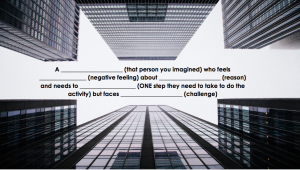
What I’m Watching: Oh, man. I am deep in a YA Netflix binge of “All-American”. I’m a sucker for shows about teens moving from a poor neighborhood to a rich neighborhood AND inspirational sports stories. And it has Taye Diggs.
What I’m Reading: Currently on the third book in my one-person “Democratic Presidential Candidate Memoir” book club. Making my way through “The Truths We Hold” by Kamala Harris and I am in love with her.
What I’m Listening To: Ambient sounds and words that calm me on Headspace and my new favorite app Sanity and Self
TL;DR–Everyone deserves the opportunity to be heard and to be understood. Empathy should be at the core of policy design. Also, Mean Girls. (PS find me on Twitter @SarahKCMO to talk about all this)
WARNING: This might be the longest Morning Buzz in history. Please check the records to confirm this.

How many airports have you cried in?
There is something about an airport that brings emotions to the forefront. Tearful goodbyes, happy reunions, stressed out travelers, nervous flyers, strangers passing, paying 20 bucks for a Bloody Mary. There have been many times I tried to order a Bloody Mary in an airport bar only to be told, “I’m sorry ma’am, we aren’t allowed to serve those until 7am”

The last airport I cried in was the St. Louis Airport, waiting for a connecting flight home. It was over a slice of very bad pizza, smothered in Provel (it’s a thing, I’m told, that STL lays claim to. Never have I ever heard of a city laying claim to processed cheese food with the tenacity that STL does. It is second only to their claim they invented toasted ravioli, which I find hard to believe).

The thing that set me off this time started benignly, though I should have seen the warning signs of a breakdown from far away. I am trying to be a mindful person, thanks to the $17.99 I spend a month on mindfulness apps. I knew that the conditions were ripe for a patented “Sarah Martin” cry-fest(TM)—a day of traveling, a sad looking pizza, a glass of Pinot Grigio.
I got a text from my teen daughter on behalf of her older brother saying that his phone had died, never to be resurrected. I did the mental calculations about whether it made more sense to replace said sub-par phone or upgrade it to an iPhone. In my head, the iPhone made the most sense. But my loving travel partner said something to the effect of “Kids don’t deserve iPhones, why would you buy him one?”
[cue that face you make in public when you want to cry so bad but you are trying to stay calm and hold it together]
I boarded the plane keeping back tears, and the minute the cabin lights were dimmed, I turned my face towards the window and sobbed quietly. I sobbed for the entire 30 minute flight. I struggled to understand why I was so worked up about providing this stupid phone for my kid who—in my loving travel partner’s defense—didn’t earn a flagship phone and had no real need for something so nice. I could not figure out why this was hitting me so hard. And so I did what I normally do in these situations… I opened my laptop and started typing, stream of consciousness style. And these are the first words I wrote:
“This isn’t about the phone. This is about those damn jeans”
Let’s travel back to 6th grade Sarah. The year is 1993. My parents had done what they thought was best—rented an apartment in a school catchment area for the best new elementary school in the city. My classmates had money. A lot of it. We, on the other hand, did not. My mom worked at a grocery store and my dad was a landscaper. Neither went to college, though both were definitely smart enough to. College wasn’t the family tradition. In fact, it was one of my best friend’s parents who helped me fill out my FAFSA years later (thank you Mr. and Mrs. Fiori!)
In my mind, there were three things that set rich kids apart from poor kids: a Kitchen Island; having either a den or a formal dining room (or both); and Bongo Jeans.

Bongo Jeans were sold at the mecca for teenage girl fashion–Wet Seal. All the coolest, most popular 6th grade girls shopped exclusively at Wet Seal. These girls were Bakersfield royalty. I hung out with an eclectic little crew of girls–some athletes, some brains, some “skater girls” (not sure to what extent they skated or whether they just liked to kool-aid their hair), some rich and some poor. The beautiful queens of Wet Seal were not in my universe.
Until one day…
My friends decided that on Friday, everyone would wear a French Braid. Unfortunately, my mom didn’t know how to do this and so I was left out of the exciting Friday French Braid Day. (Side note, my own daughter has been french and dutch braiding her own hair thanks to YouTube tutorials since about age 8)
When Annelise (not her real name)–the most popular girl in school–saw that I was the only one in my circle of friends without a French Braid she said, while casting side eye to these girls, “What a stupid idea. Good for you for not joining in”.
So instead of correcting her and saying “well, actually, my mom grew up kind of a tomboy and she doesn’t know how to braid hair and YouTube hasn’t been invented yet and even if it was I don’t think I have the hand eye coordination…”, I went along with it, pretending like I was some sort of free-thinking independent woman. And then she said what–for 6th grade girls who are renters amidst a sea of homeowners–is the single most important and meaningful thing you can ever hear:
“So, do you wanna hang out with us instead?”
And this was that moment you look back on decades later and decide whether it will go into your eventual presidential candidate memoir and how truthful the story will be. Do I look back and decide that I was the kind of girl who stayed loyal to her quirky and cute group of friends? That I was not the kind of human to be swayed by the sparkle and shine of the queens of Wet Seal? Or do I tell the truth? That I bolted to the most popular group of girls as soon as I could? That I got a glimpse into the life of wealth and swimming pools and catered sleepovers and walk-in closets and wanted all of it?
One day, Annelise looked at me and said “I hope you’re asking for some Wet Seal gift certificates for your birthday because I don’t know if you can hang out with us anymore with those clothes”
I won’t belabor the way that made me feel. Heartbreak doesn’t require a lot of words. I will choose not to focus on the tears and the hurt and instead tell you about the feeling of getting a gift card, showing up at school in some Bongo Jeans and seeing Annelise run towards me and hug me and say “FINALLY! You look so cute!”
It is impossible to empathize with others if we have not done the hard work of empathizing with ourselves. If we don’t understand our own motivations and intentions we can not even begin to approach the experience of the people we serve.
What I could have said in the St. Louis Airport, had I not been on the verge of ugly crying about my son’s phone, is this:
“I feel strongly about _______________________ because _____________________ happened to me and it’s making me feel a lot of _________________________ and _______________________”
I felt strongly about my son having the best thing as a symbol of the fact that I can take care of him and give him nice things because I always felt poor and less-than when I was a kid and it’s making me feel a lot of sadness and bringing up old memories.
Imagine the application of self-empathy for our policy-making lives! Is there one time this week you can ask yourself: “why do I feel so strongly? What is really going on here? Why am I unwilling to compromise?” Use the mad lib style prompt I just shared, and share it with me (publicly or privately, totally your call. I will never Annelise-shame you.)
If we extend a design-thinking approach rooted in empathy to our policy and program development, good people are unstoppable.
If we understand our own complex motivations and how that colors our experience, we can then turn to the outside world and get to work. Part of why I love mySidewalk is that everything we do and create is driven by user experience–understanding the needs of the end-user and how that manifests into behavior when interacting with data and technology.
There’s a mental exercise I like to pose to public sector folks straight from Design Thinking 101 that I think is the most useful thing any public servant can do. I ask the room to close their eyes, and pretend they are someone else–it’s like a mash up of d.school and my HS improv team. I ask them to try and think of someone they see in their community. I ask them to imagine their face, their height, their skin color, the way they talk. I ask them to think of an activity that person has to do every day, the reason they do it and three steps they have to go through in order to complete that task.
Then I make them fill in the blanks:

That person feels a negative feeling about doing a task because of the structural obstacles in their way.
I’ve seen powerful realizations from this exercise that lead to creative, human-centered solutions: the mother with small children who has to grocery shop via bus chooses lighter, less nutritious foods because it’s hard to carry heavy bags and kids. The elderly man aging-in-place who tries to get to church but is nervous about crossing a certain street because the crosswalk signals are too fast. The pregnant woman who wants to get regular prenatal care but feels judged by the last doctor she saw because of her HIV-positive status.
These residents weren’t in the room while solutions were being created (we can cover meaningful engagement of oppressed communities in another post), but people with power and agency to implement policy solutions were, and by rooting the conversation in empathy, we create healthier, more ambitious policymakers with a greater sense of urgency to solve problems.
Epilogue
I learned a lesson when it was time to leave 6th grade for Junior High. Annelise quickly stopped being my friend when I shared my first kiss with the boy she laid claim to. I decided the glamour of the rich kids wasn’t my style, and tried on the persona of the type of girl who shops at vintage stores and wears cat eye glasses and listens to bands “you probably have never heard of”.
Years later at our 10 year high school reunion, I ran into Annelise in the bathroom. We had one of those lady-chats that end in a few tears and somehow includes every other woman in the bathroom. Annelise said she was sorry for being so mean, that she was ashamed at the kid she was. I said I was sorry for kissing Derek. We complemented each other’s dresses and hugged.
And then she said “I was always such a mean girl, because I was so terrified that people would find out I wasn’t anything special. I wasn’t as smart as you, or as pretty as Nicole or as rich as Naomi. All I had was my power.”
And this is the hardest part of empathy–extending it to the people who have hurt you, or people you don’t think deserve it. This is the calling of public service… to understand the motivations of the hardest to understand.
Because even Annelise deserves that much.
